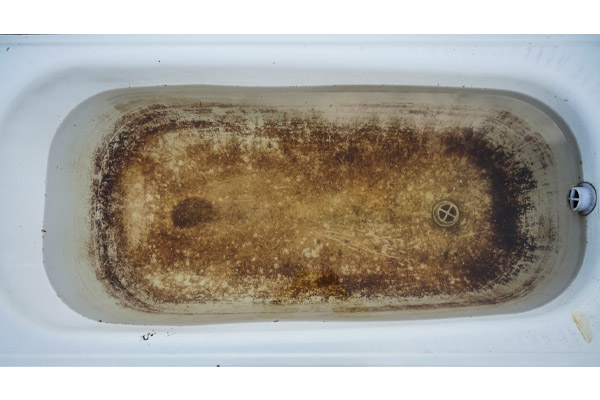Important Factors Behind Sewage in the Bathtub
Important Factors Behind Sewage in the Bathtub
Blog Article
Just about everyone seems to have their unique way of thinking when it comes to Why is Sewage Backing Up Into My Bathtub?.

Sewer backup in the tub can be a stressful and unsanitary issue for any type of house owner. Not just is it bothersome, however it additionally positions significant wellness threats and indicates underlying problems with the plumbing system. Recognizing why sewer is showing up with the bathtub is essential for taking appropriate activity to address the trouble efficiently.
Introduction to the Concern
Usual Factors for Sewage Backup
Obstructions in the Sewage System Line
One of the most usual causes of sewage backup is a blockage in the sewage system line. This can happen as a result of the accumulation of debris, grease, or international things in the pipelines, avoiding correct circulation and creating sewer to back up right into your tub.
Tree Origin Intrusion
Tree origins seeking wetness and nutrients can penetrate drain lines via tiny splits or joints. Gradually, these origins can expand and broaden, triggering significant damages to the pipes and causing sewage backup issues.
Comprehending the Issue
When sewer draws back up into the bath tub, it's a clear indication of an issue with the drainage system. The wastewater that should be moving away from your home is instead locating its back into your space, which can bring about significant damage and carcinogen.
Potential Causes
Numerous variables can add to sewage backup in the tub. From blockages in the drain line to problems with the plumbing framework, recognizing the origin is essential for locating a service.
Aging Infrastructure
Older homes may have obsoleted plumbing systems that are extra prone to corrosion, fractures, and wear and tear. As pipelines age, they come to be a lot more susceptible to leaks and obstructions, boosting the chance of sewage back-up occurrences.
Heavy Rainfall or Flooding
During durations of heavy rainfall or flooding, the drain system may come to be overwhelmed with excess water, triggering back-ups and overflows. This can cause sewage supporting right into tubs and other fixtures inside the home.
Indications of Sewage Backup
Foul Odors
Unpleasant smells rising from drains pipes or components, especially in the shower room, may show sewage backup concerns. These smells are frequently strong and persistent, signaling a trouble that needs immediate attention.
Slow Draining Fixtures
Bath tubs, sinks, and commodes that drain pipes gradually or otherwise whatsoever could be experiencing sewer backup. If several fixtures are impacted concurrently, it's most likely that the issue stems from a typical point, such as the main sewage system line.
Gurgling Sounds
Weird gurgling or bubbling noises originating from drains when water is running elsewhere in the house are indicative of air trapped in the plumbing system. This air buildup can arise from sewage back-up and ought to be investigated quickly.
Health Dangers Associated with Sewer Back-up
Contamination of Water Supply
Sewage backup can pollute the water in your house, positioning a severe wellness danger to you and your family members. Direct exposure to infected water can cause stomach concerns, skin infections, and other ailments.
Mold and mildew Growth
Dampness from sewer back-up can produce perfect problems for mold growth in your home. Mold and mildew spores can exacerbate respiratory system issues and cause allergies in delicate people, making prompt cleanup vital.
Spread of Illness
Sewer includes dangerous germs, viruses, and parasites that can trigger a series of illness, including liver disease, cholera, and gastroenteritis. Entering into contact with sewage or contaminated surface areas puts you at risk of infection.
Tidying up After Sewage Back-up
Disinfection Procedures
Thoroughly decontaminate and sanitize affected areas after sewer backup to get rid of dangerous germs and avoid mold and mildew development. Usage proper cleansing items and safety gear to make sure risk-free and efficient clean-up.
Restoration of Impacted Locations
Fix any damage to flooring, walls, or fixtures caused by sewer backup. Depending on the degree of the damages, you may require to change carpets, drywall, or various other materials to recover your home to its pre-loss condition.
Immediate Actions to Take
Switching Off Water Supply
In case of sewage back-up, it's essential to turn off the water to prevent further contamination and damages. Situate the major water shutoff valve in your house and closed it off up until the problem can be solved.
Speaking To a Specialist Plumber
Dealing with sewer back-up is not a DIY work. Contact an accredited plumber with experience in handling sewage-related problems to examine the situation and execute required repair services or cleanings.
Avoiding Contact with Contaminated Water
Up until the sewage backup is settled, stay clear of contact with infected water to stop the spread of bacteria and virus. Wear protective equipment if you have to remain in the affected location and wash your hands completely afterward.
Preventive Measures
Regular Maintenance of Sewer Lines
Schedule routine inspections and upkeep of your sewage system lines to recognize and deal with prospective issues prior to they intensify right into major troubles. This can include cleaning particles, examining for tree root invasion, and fixing any damaged pipes.
Setting Up Backwater Shutoffs
Take into consideration mounting bayou shutoffs in your plumbing system to stop sewer from flowing back into your home throughout periods of heavy rainfall or flooding. These valves automatically close when water starts backing up, securing your property from contamination.
Appropriate Disposal of Family Waste
Prevent flushing anything apart from toilet paper and human waste down the toilet to avoid obstructions and clogs in the drain line. Dispose of oil, oil, and various other home chemicals properly to reduce the threat of plumbing issues.
What To Do If Sewage Starts Coming Up Through Your Bathtub
Sewage coming up through your bathtub is more than just gross. It poses a major health risk as sewage contains harmful bacteria and microorganisms that can be dangerous if exposed to them. While your tub or shower will certainly need a deep cleaning when this occurs, you’ll first need to get to the root of the issue.
If you notice sewage coming up through your bathtub, research Cherry Hill, NJ, licensed plumbers right away to get it fixed.
Why Sewage Is Coming Up Through Your Bathtub
The most common reason for sewage coming up through your bathtub is a clogged sewer line. All the sinks, toilets, and tubs connect to a single drain pipe that leads to the sewer line under your house. This drain line carries all wastewater and sewage away from your home to the city’s sewer system.
When the sewer line becomes clogged or blocked, wastewater has nowhere to go but back toward your house. This results in sewage coming up through your drains, often starting with your tub or shower.
The sewer line can become blocked by anything, but the most common culprits include:
Hair ? Cooking oils and grease ? Food waste ? Soap particles ? Children’s toys ? Jewelry ? Baby wipes or other non-flushable items ? Dirt ? Rocks ? Tree branches and debris ? Rodents How To Fix A Clogged Sewer Line
When you experience sewage coming up through your bathtub, it’s always best to contact a professional. Attempts to fix a clogged sewer line without experience often lead to more plumbing damage. However, you can try a few things that may loosen blockages in smaller connecting pipes.
Don’t Use A Plunger
Plungers only work to loosen obstructions near the head of the drain or toilet. It won’t be able to reach your sewer line or unclog the blockage.
Turn Off The Water
Turning the water off from the main valve will prevent excess water from flowing into already backed-up areas. This will also keep more sewage from coming up through your drains.
Check Your Vent Pipe
When vent pipes become clogged or blocked, it can lead to problems with the sewer line. By pulling any obstructions out of the pipe, your sewer line should be able to properly drain. The vent pipe can be located on your roof, usually directly over your bathroom.
Snake The Shower Drain And Toilet
Using a drain snake can help break up the object causing a blockage. By snaking both the shower drain and the toilet, you may be able to fix the issue. You’ll know you’re successful if the tub drains all sewage and wastewater.
Call A Professional
If these tactics don’t work, you will need to call a professional plumber. They will perform a camera sewer line inspection to find the source of the blockage and determine the best way to remove it. A professional will use a drain snake or conduct hydro jetting to unblock the sewer line and get things back in working condition.
If the obstacle blocking your drain line has caused any damage, you may also need your pipes repaired or even replaced.
Gurgling While Draining
Listen for gurgling sounds coming from the shower drain or sink, as this is an early warning sign of a clogged sewer line.
Frequent Clogs
If your toilet or other drains continuously become clogged, you need to call a professional to look at it. While you may be able to get the water or waste to drain again, it may only be a temporary fix.

As a devoted person who reads on What to Do if Sewage Starts Coming Up Through Your Bathtub, I think sharing that piece of writing was really useful. Sharing is good. Helping people is fun. Many thanks for going through it.
Explore
Report this page